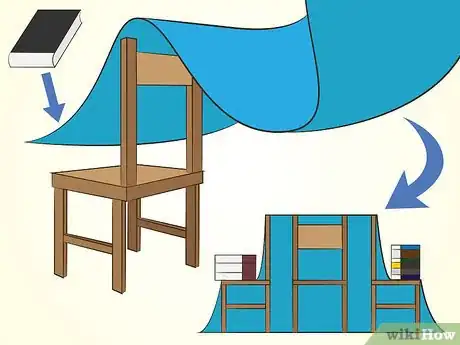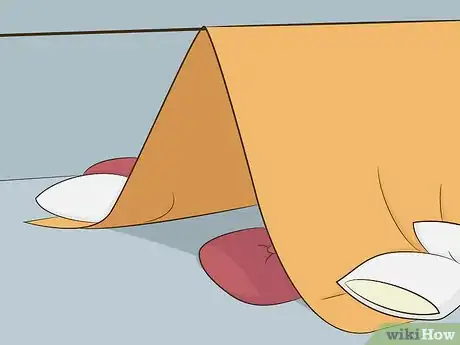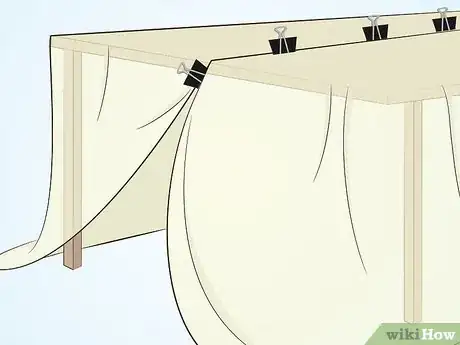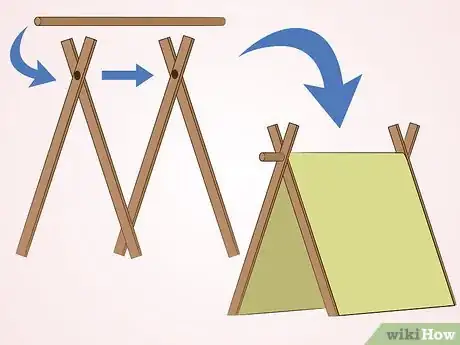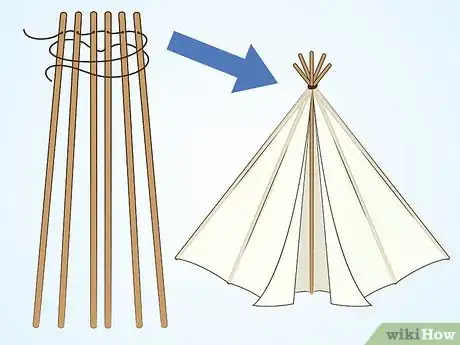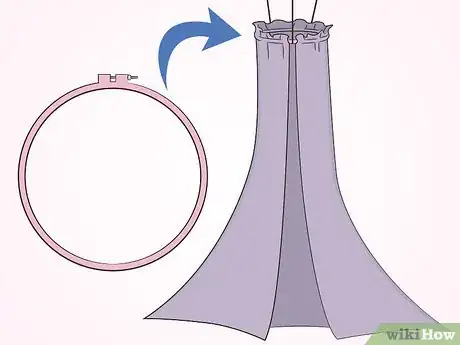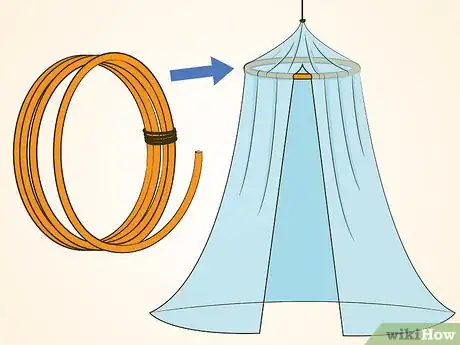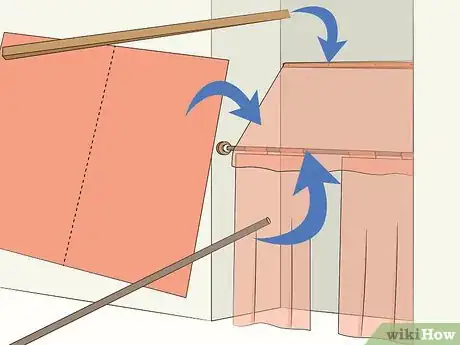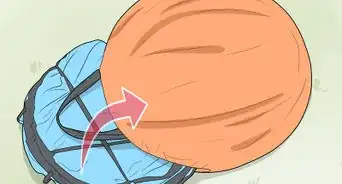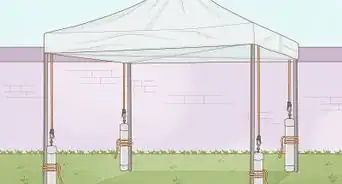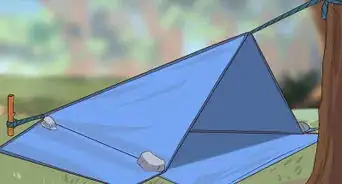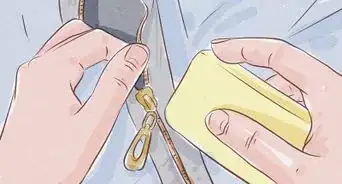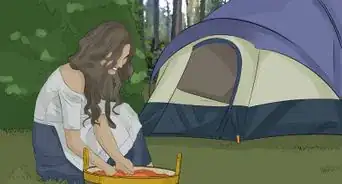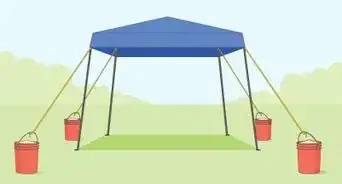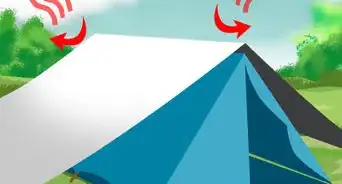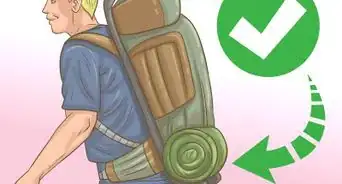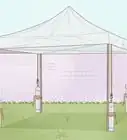This article was co-authored by wikiHow Staff. Our trained team of editors and researchers validate articles for accuracy and comprehensiveness. wikiHow's Content Management Team carefully monitors the work from our editorial staff to ensure that each article is backed by trusted research and meets our high quality standards.
There are 7 references cited in this article, which can be found at the bottom of the page.
This article has been viewed 190,400 times.
Learn more...
Tents are fun for kids and adults alike. Tents are fun for playing house or for gathering during story time.They make great reading nooks, meditation spaces, or just quiet spaces in which to hide away. You can make a simple temporary tent or a more permanent sheltered area, depending on the time and supplies available.
Steps
Temporary Tents
-
1Create a classic fort-tent. This tent is definitely one you'll need to take down at the end of the day or in a day or two. Drag pieces of furniture together. Throw fabric over the top, such as a large sheet, and weigh down the sheet on the outside with pillows.[1]
- If you place chairs facing outward, throw the sheet over the tops, and let it hang down to the seats on the outside. Then, place pillows or books on top of the sheet where it rests on the seat of the chairs.
- For a bigger tent, use binder clips to attach one sheet to another.
-
2Use fabric and a string. For a simple tent, tighten a string between two sturdy points. Throw a sheet over it in an a-frame shape to create a simple, quick setup tent. Add some pillows below, and you're good to go.[2]
- For another option, run a dowel under the fabric, then use strings on the end to attach it to the ceiling.
Advertisement -
3Make a tent out of your table. Find a tablecloth that runs all the way to the floor. Throw it over the table to create the tent. To get into the tent, just duck under an edge. If you want a more permanent door, pin or clip an edge up.[3]
- Create your own tent-tablecloth by cutting a piece of fabric slightly bigger than your tabletop. Sew or glue a skirt on that goes all the way around the table, leaving a slit on one side. Hem the fabric to make it last longer, or use a fabric that doesn't fray, such as fleece.
Permanent Moveable Tents
-
1Make an a-frame tent. Measure half a foot down on each of 4 pieces of 1-inch by 2-inch by 48-inch whitewood molding or other similar wood. Drill a 3/4 of an inch hole where you've marked on the wood. Insert the wooden dowel through all the holes.[4]
- You should have two pieces of wood near each end of the dowel. On each end, spread the two pieces in opposite directions to create the "A" frame.
- Sew elastic loops on the corners of a twin sheet. Throw the sheet over the frame, and loop the elastic over the end of each piece of wood to hold it in place.
-
2Use PVC pipe. PVC pipe is lightweight and cheap. You just need to buy pipe and connectors to make a large cube (or an a-frame or house shape) in the size you want. Cut the pipe smaller if you need to. To finish, throw a sheet over the tent.[5]
- To help the sheet stay in place, create sleeves for your sheet, and thread them through two of the bottom edges.
- The best part of this type of tent is you can take it apart. It's lightweight and travels easily.
-
3Create a teepee. Buy six dowel rods in your preferred height. Drill holes in them about half a foot from the top. Thread a string through all of them, then gather them together. Spread them out into a teepee shape, and wrap the rope around them to stabilize the shape at the top.[6]
- To make the fabric, measure how far apart you've spread your teepee. Measure at the bottom of one of the triangles, then measure up each side to where you want the fabric to reach. Cut triangles in fabric that are the same size, with an extra inch on each side for hemming.
- Make a triangle for each of the five sides. Sew the triangles together, and hem the bottom. Sew a tie across the top for tying it together in the front. It also helps to sew ties to the inside at the seams, which allows you to tie the fabric to the poles. Pull the fabric over the frame, and tie it in place.
Permanent Indoor Tents
-
1Make a canopy tent with a plastic embroidery hoop. Start with a small plastic embroidering hoop. Get rid of the inner part, and unscrew the outer part. Thread on two curtain panels, each 44-inches. They should be facing outward.[7]
- To hang it, tie (1/2-inch) ribbon or yarn on each side of the hoop, where the curtains meet. Tie them in a knot or bow above the embroidery hoop. Hang it on a screw hook in the ceiling.
-
2Make a canopy tent with PEX pipe and a curtain. PEX pipe is flexible plastic pipe; find it at hardware stores. You'll need 1/2 inch tubing and a 1 1/2-inch coupling to connect it. You'll also need a long curtain panel.
- Cut off about 14 inches from the bottom of the curtain. If the bottom doesn't have a sleeve, sew or use fabric glue to create one. Sew or use fabric glue to attach the fabric to the top of the curtain (the unhemmed side), leaving the sleeve on the top of the curtain open.
- Thread the pipe into the original curtain's sleeve. Attach it with the coupling. Thread a string through the sleeve you created. Gather up the fabric, and tie the string in a knot or bow. Attach it to the ceiling with a hook.
-
3Use a convenient nook to make a permanent tent. If you have a small nook in your home, use a tension rod (the width of the nook) to make a tent. You'll also need a flat wood shim slightly smaller than the nook, as well as some screws and a drill.
- Get a piece of fabric wide enough for the nook, and long enough to go from front to back and to the floor. Decide where your shim on the wall is going to go. It should be higher than the tension rod in the front, which will be the height of your tent.
- Cut the fabric in two, so that one piece is long enough to go from the shim to the tension rod, with extra inches on each side. The other piece should be long enough to reach the floor from the tension rod, with extra inches on either side.
- Glue or hem three sides of the top piece of fabric, but leave the top unhemmed. On the bottom edge, make three loops on the underside of the fabric, spread out along the fabric. Glue the top edge to the shim, and screw it into studs in the wall with the fabric edge towards the wall. On the bottom piece of fabric, hem three sides (bottom and both sides). Make a sleeve with the top edge. Push the tension rod through one loop of the fabric, then push in the sleeve of the other fabric. Pull the last two loops on, and hang up the tension rod.
Community Q&A
-
QuestionWhat if you have no clips?
 Community AnswerTry some safety pins, rope or strong string, paper clips, staples, or just tie them together.
Community AnswerTry some safety pins, rope or strong string, paper clips, staples, or just tie them together. -
QuestionHow do I make rooms in the tent?
 Community AnswerJust put one more blanket inside the tent and clip it with clips. You may add more blankets for more rooms.
Community AnswerJust put one more blanket inside the tent and clip it with clips. You may add more blankets for more rooms. -
QuestionCan I use a broom to create an indoor tent?
 Anya G.Community AnswerYes, but you will need to secure it to a chair or couch. Make sure you don't cover it with a heavy comforter, though.
Anya G.Community AnswerYes, but you will need to secure it to a chair or couch. Make sure you don't cover it with a heavy comforter, though.
References
- ↑ https://www.cnet.com/culture/internet/ikea-shares-instructions-for-building-comfy-homemade-forts-and-tents/
- ↑ https://www.brit.co/diy-tents/
- ↑ http://centsationalgirl.com/2013/01/diy-tablecloth-play-tent/
- ↑ http://builtbykids.com/build-a-beautiful-indoor-a-frame-kids-tent/
- ↑ http://www.sew4home.com/projects/curtains-panels/playhouse-tent-lounge-cabana
- ↑ http://the-thud.com/diy-kids-teepee/
- ↑ http://www.countryliving.com/diy-crafts/how-to/a2870/diy-canopy-bed-0709/
About This Article
An indoor tent can be a fun place for you to hang out, read, meditate, or play games. If you want to create a temporary indoor tent, you can combine pieces of furniture to build a fort. Throw fabric over the top, like a large sheet, and weigh it down with pillows. You can also tighten a string between 2 sturdy points, throw a sheet over it in an a-frame shape, and add pillows to hold the edges down. Another option is to find a tablecloth that runs all the way to the floor, toss it over your table, and pin or clip an edge up to create a door. To learn how to create a permanent moveable indoor tent, keep reading!
